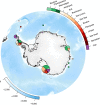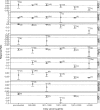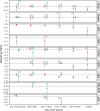Effects of ocean acidification on Antarctic marine organisms: A meta-analysis
- PMID: 32489613
- PMCID: PMC7246202
- DOI: 10.1002/ece3.6205
Effects of ocean acidification on Antarctic marine organisms: A meta-analysis
Abstract
Southern Ocean waters are among the most vulnerable to ocean acidification. The projected increase in the CO2 level will cause changes in carbonate chemistry that are likely to be damaging to organisms inhabiting these waters. A meta-analysis was undertaken to examine the vulnerability of Antarctic marine biota occupying waters south of 60°S to ocean acidification. This meta-analysis showed that ocean acidification negatively affects autotrophic organisms, mainly phytoplankton, at CO2 levels above 1,000 μatm and invertebrates above 1,500 μatm, but positively affects bacterial abundance. The sensitivity of phytoplankton to ocean acidification was influenced by the experimental procedure used. Natural, mixed communities were more sensitive than single species in culture and showed a decline in chlorophyll a concentration, productivity, and photosynthetic health, as well as a shift in community composition at CO2 levels above 1,000 μatm. Invertebrates showed reduced fertilization rates and increased occurrence of larval abnormalities, as well as decreased calcification rates and increased shell dissolution with any increase in CO2 level above 1,500 μatm. Assessment of the vulnerability of fish and macroalgae to ocean acidification was limited by the number of studies available. Overall, this analysis indicates that many marine organisms in the Southern Ocean are likely to be susceptible to ocean acidification and thereby likely to change their contribution to ecosystem services in the future. Further studies are required to address the poor spatial coverage, lack of community or ecosystem-level studies, and the largely unknown potential for organisms to acclimate and/or adapt to the changing conditions.
Keywords: CO2; Southern Ocean; bacteria; climate change; fish; invertebrates; macroalgae; pH; phytoplankton.
© 2020 The Authors. Ecology and Evolution published by John Wiley & Sons Ltd.
Conflict of interest statement
None declared.
Figures










References
-
- Allgaier, M. , Riebesell, U. , Vogt, M. , Thyrhaug, R. , & Grossart, H.‐P. (2008). Coupling of heterotrophic bacteria to phytoplankton bloom development at different pCO2 levels: A mesocosm study. Biogeosciences, 5(1), 317–359.
-
- Amsler, C. D. , Rowley, R. J. , Laur, D. R. , Quetin, L. B. , & Ross, R. M. (1995). Vertical distribution of Antarctic Peninsular macroalgae: Cover, biomass and species composition. Phycologia, 34(5), 424–430.
-
- Andersson, A. , Mackenzie, F. , & Gattuso, J.‐P. (2011). Effects of ocean acidification on benthic processes, organisms, and ecosystems In Gattuso J.‐P., & Hansson L. (Eds.), Ocean acidification (pp. 122–150). New York, NY: Oxford University Press.
-
- Ansell, A. D. , & Harvey, R. (1997). Protected larval development in the Antarctic bivalve Laternula elliptica (King and Broderip) (Anomalodesmata: Laternulidae). Journal of Molluscan Studies, 63(2), 285–286.
Publication types
LinkOut - more resources
Full Text Sources

